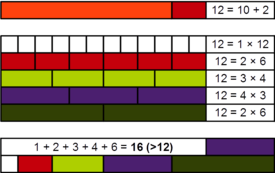Abundant number

In number theory, an abundant number or excessive number is a number for which the sum of its proper divisors is greater than the number itself. The integer 12 is the first abundant number. Its proper divisors are 1, 2, 3, 4 and 6 for a total of 16. The amount by which the sum exceeds the number is the abundance. The number 12 has an abundance of 4, for example.
Definition
A number n for which the sum of divisors σ(n)>2n, or, equivalently, the sum of proper divisors (or aliquot sum) s(n)>n.
Abundance is the value σ(n)-2n (or s(n)-n).
Examples
The first few abundant numbers are:
- 12, 18, 20, 24, 30, 36, 40, 42, 48, 54, 56, 60, 66, 70, 72, 78, 80, 84, 88, 90, 96, 100, 102, 104, 108, 112, 114, 120, … (sequence A005101 in the OEIS).
For example, the proper divisors of 24 are 1, 2, 3, 4, 6, 8, and 12, whose sum is 36. Because 36 is more than 24, the number 24 is abundant. Its abundance is 36 − 24 = 12.
Properties
- The smallest odd abundant number is 945.
- The smallest abundant number not divisible by 2 or by 3 is 5391411025 whose distinct prime factors are 5, 7, 11, 13, 17, 19, 23, and 29 (sequence A047802 in the OEIS). An algorithm given by Iannucci in 2005 shows how to find the smallest abundant number not divisible by the first k primes.[1] If represents the smallest abundant number not divisible by the first k primes then for all we have:
- for sufficiently large k.
- Infinitely many even and odd abundant numbers exist.
- The set of abundant numbers has a natural density.[2] Marc Deléglise showed in 1998 that the natural density of the set of abundant numbers and perfect numbers is between 0.2474 and 0.2480.[3]
- Every multiple (beyond 1) of a perfect number is abundant.[4] For example, every multiple of 6 is abundant because the divisors include 1, n/2, n/3, and n/6 which sum to n + 1.
- Every multiple of an abundant number is abundant.[4] For example, every multiple of 20 (including 20 itself) is abundant because n/2 + n/4 + n/5 + n/10 + n/20 = n + n/10.
- Every integer greater than 20161 can be written as the sum of two abundant numbers.[5]
- An abundant number which is not a semiperfect number is called a weird number.[6] An abundant number with abundance 1 is called a quasiperfect number, although none have yet been found.
Related concepts
Numbers whose sum of proper factors equals the number itself (such as 6 and 28) are called perfect numbers, while numbers whose sum of proper factors is less than the number itself are called deficient numbers. The first known classification of numbers as deficient, perfect or abundant was by Nicomachus in his Introductio Arithmetica (circa 100), which described abundant numbers as like deformed animals with too many limbs.
The abundancy index of n is the ratio σ(n)/n.[7] Distinct numbers n1, n2, ... (whether abundant or not) with the same abundancy index are called friendly numbers.
The sequence (ak) of least numbers n such that σ(n) > kn, in which a2 = 12 corresponds to the first abundant number, grows extremely quickly (sequence A134716 in the OEIS).
If p = (p1,...,pn) is a list of primes, then p is termed abundant if some integer composed only of primes in p is abundant. A necessary and sufficient condition for this is that the product of pi/(pi-1) be at least 2.[8]
References
- ↑ D. Iannucci (2005), "On the smallest abundant number not divisible by the first k primes", Bulletin of the Belgian Mathematical Society, 12 (1): 39–44
- ↑ Hall, Richard R.; Tenenbaum, Gérald (1988). Divisors. Cambridge Tracts in Mathematics. 90. Cambridge: Cambridge University Press. p. 95. ISBN 0-521-34056-X. Zbl 0653.10001.
- ↑ Deléglise, Marc (1998). "Bounds for the density of abundant integers". Experimental Mathematics. 7 (2): 137–143. doi:10.1080/10586458.1998.10504363. ISSN 1058-6458. MR 1677091. Zbl 0923.11127.
- 1 2 Tattersall (2005) p.134
- ↑ "Sloane's A048242 : Numbers that are not the sum of two abundant numbers". The On-Line Encyclopedia of Integer Sequences. OEIS Foundation.
- ↑ Tatersall (2005) p.144
- ↑ Laatsch, Richard (1986). "Measuring the abundancy of integers". Mathematics Magazine. 59 (2): 84–92. ISSN 0025-570X. JSTOR 2690424. MR 0835144. Zbl 0601.10003.
- ↑ Friedman, Charles N. (1993). "Sums of divisors and Egyptian fractions". Journal of Number Theory. 44 (3): 328–339. doi:10.1006/jnth.1993.1057. MR 1233293. Zbl 0781.11015.
- Tattersall, James J. (2005). Elementary Number Theory in Nine Chapters (2nd ed.). Cambridge University Press. ISBN 0-521-85014-2. Zbl 1071.11002.
